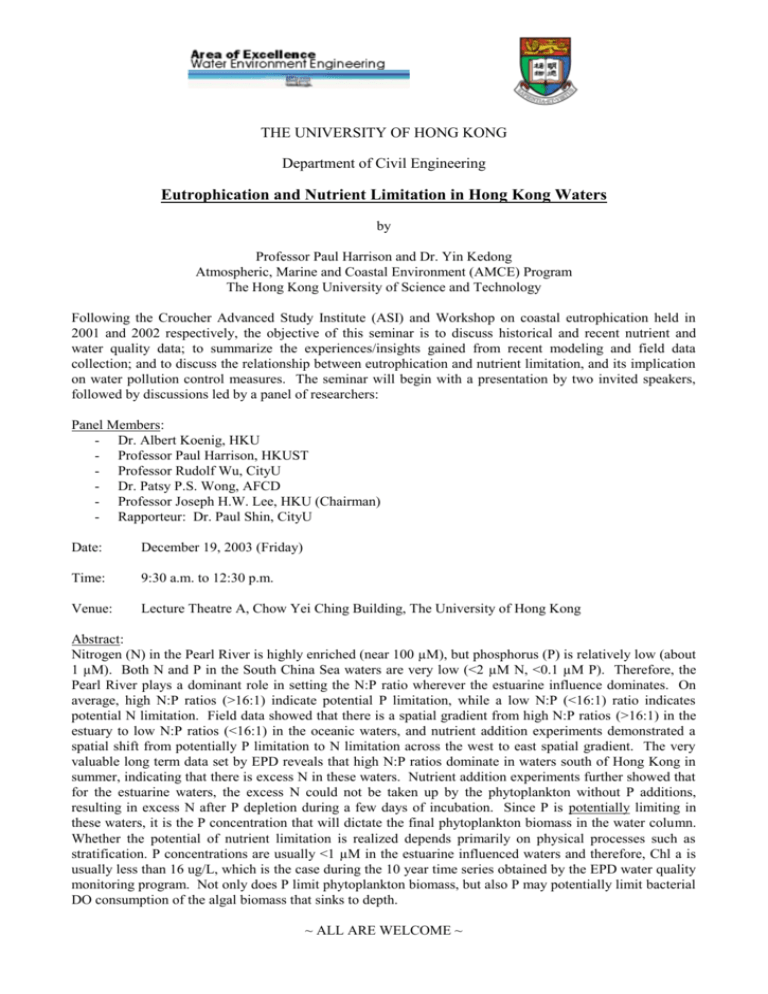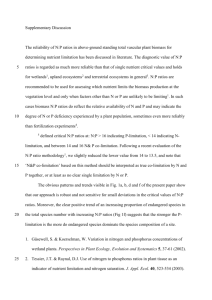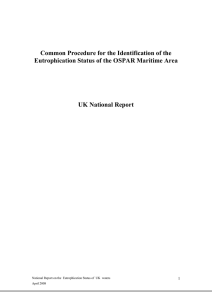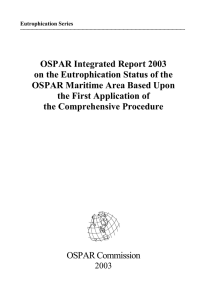Seminar Notice - Water Environment Engineering
advertisement

THE UNIVERSITY OF HONG KONG Department of Civil Engineering Eutrophication and Nutrient Limitation in Hong Kong Waters by Professor Paul Harrison and Dr. Yin Kedong Atmospheric, Marine and Coastal Environment (AMCE) Program The Hong Kong University of Science and Technology Following the Croucher Advanced Study Institute (ASI) and Workshop on coastal eutrophication held in 2001 and 2002 respectively, the objective of this seminar is to discuss historical and recent nutrient and water quality data; to summarize the experiences/insights gained from recent modeling and field data collection; and to discuss the relationship between eutrophication and nutrient limitation, and its implication on water pollution control measures. The seminar will begin with a presentation by two invited speakers, followed by discussions led by a panel of researchers: Panel Members: - Dr. Albert Koenig, HKU - Professor Paul Harrison, HKUST - Professor Rudolf Wu, CityU - Dr. Patsy P.S. Wong, AFCD - Professor Joseph H.W. Lee, HKU (Chairman) - Rapporteur: Dr. Paul Shin, CityU Date: December 19, 2003 (Friday) Time: 9:30 a.m. to 12:30 p.m. Venue: Lecture Theatre A, Chow Yei Ching Building, The University of Hong Kong Abstract: Nitrogen (N) in the Pearl River is highly enriched (near 100 µM), but phosphorus (P) is relatively low (about 1 µM). Both N and P in the South China Sea waters are very low (<2 µM N, <0.1 µM P). Therefore, the Pearl River plays a dominant role in setting the N:P ratio wherever the estuarine influence dominates. On average, high N:P ratios (>16:1) indicate potential P limitation, while a low N:P (<16:1) ratio indicates potential N limitation. Field data showed that there is a spatial gradient from high N:P ratios (>16:1) in the estuary to low N:P ratios (<16:1) in the oceanic waters, and nutrient addition experiments demonstrated a spatial shift from potentially P limitation to N limitation across the west to east spatial gradient. The very valuable long term data set by EPD reveals that high N:P ratios dominate in waters south of Hong Kong in summer, indicating that there is excess N in these waters. Nutrient addition experiments further showed that for the estuarine waters, the excess N could not be taken up by the phytoplankton without P additions, resulting in excess N after P depletion during a few days of incubation. Since P is potentially limiting in these waters, it is the P concentration that will dictate the final phytoplankton biomass in the water column. Whether the potential of nutrient limitation is realized depends primarily on physical processes such as stratification. P concentrations are usually <1 µM in the estuarine influenced waters and therefore, Chl a is usually less than 16 ug/L, which is the case during the 10 year time series obtained by the EPD water quality monitoring program. Not only does P limit phytoplankton biomass, but also P may potentially limit bacterial DO consumption of the algal biomass that sinks to depth. ~ ALL ARE WELCOME ~











